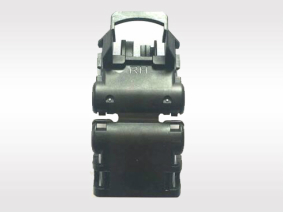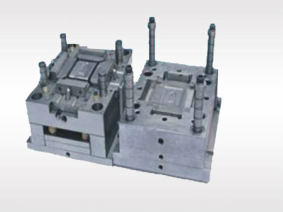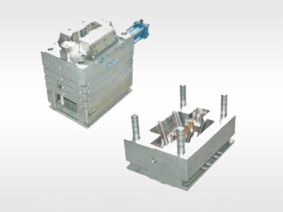Stamping die is the main technological equipment of stamping process, stamping parts are completed by the relative movement of upper and lower dies. Because of the continuous opening and closing between the upper and lower molds during processing, if the fingers of the operators constantly enter or stay in the closed area of the mold, it will bring serious threat to their personal safety.
Main parts and safety requirements
1. Working parts
The punch and die are the working parts that directly form the blank, so they are the key parts on the die. The punch and die are not only precise but also complex
(1) It should have enough strength and can not be broken or damaged in the stamping process;
(2) The material and heat treatment should be properly required to prevent brittle fracture due to too high hardness.
2. Positioning parts
Positioning parts are parts to determine the installation position of the blank, including positioning pin (plate), stop pin (plate), guide pin, guide plate, fixed distance side cutter, side pressure device, etc. When designing the positioning parts, it should be considered that the operation is convenient, there should be no over positioning, and the position should be easy to observe. It is better to use forward positioning, contour positioning and guide pin positioning.
3. Pressing, discharging and discharging parts
There are blank holder ring, blank holder plate and so on. The blank holder can increase the edge force on the drawing blank, so as to prevent the blank from arching and forming wrinkles under the action of tangential pressure. The function of the pressing plate is to prevent the blank from moving and bouncing. The function of ejector and discharge plate is to facilitate the removal of parts and cleaning of waste materials. They are supported by spring, rubber and air cushion push rod on the equipment, and can move up and down. The ejector should have enough jacking force and the movement should be limited. The closed area of the discharge plate should be reduced as much as possible or the empty hand slot should be milled out in the operation position. Protective plates shall be set around the exposed unloading board to prevent fingers from stretching or foreign matters from entering, and the edges and corners of the exposed surface shall be blunt.
4. Guide parts
Guide pillar and guide sleeve are the most widely used guide parts. Its function is to ensure that the punch and die in the stamping work with accurate clearance. Therefore, the clearance between guide pillar and guide sleeve should be less than blanking clearance. The guide pillar is set in the lower die base, and the upper end face of the guide pillar shall be at least 5 to 10 mm above the top surface of the upper template when the stroke is at the bottom dead center. The guide pillar should be arranged far away from the module and pressing plate, so that the operator's arm does not need to cross the guide pillar to feed and reclaim.
5. Supporting and clamping parts
It includes the upper and lower templates, die handles, punch and die fixing plates, backing plates, limiters, etc.; the upper and lower templates are the basic parts of the stamping die; other various parts are installed and fixed on them respectively. The plane size of the formwork, especially the front and rear directions, should be adapted to the parts. If it is too large or too small, it is not conducive to operation.
Some molds (blanking, punching mold) need to be set under the mold base in order to facilitate the production. At this time, it is better to connect the base plate and the template with screws, and the thickness of the two base plates should be absolutely equal. The spacing of the base plate shall be subject to the part that can be produced, and it shall not be too large to avoid the template fracture.
6. Fastening parts
It includes screw, nut, spring, pin, washer and so on. The amount of standard parts of stamping die is large, so the design and selection should ensure the need of fastening and elastic ejection, avoid exposing the fasteners on the surface operation position, and prevent bumping hands and hindering operation.
Safety points of mould design
In terms of structure, it is necessary to ensure the convenience of feeding, fixing, discharging and cleaning wastes. For the processing of small parts, it is strictly forbidden for the operator's fingers, wrists or other parts of the body to stretch into the mold area for operation; for the processing of large parts, if the operator has to work in the mold by hand, the range of entering the mold should be reduced as much as possible, and the time for a certain part of the body to stay in the mold should be shortened as much as possible. The scope of the mold dangerous area should be defined, and necessary protective measures and devices should be provided.
All kinds of parts on the mold should have enough strength and rigidity to prevent damage and deformation during use. The fastening parts should have anti loosening measures to avoid accidental injury to operators.
It is not allowed to produce waste or workpiece missile phenomenon during the processing process, which will affect the operator's attention or even injure the operator. In addition, the burr of blanking parts should be avoided to cut hands. The operator is not allowed to have too large range of action during the stamping operation to avoid losing the stable posture of the body; it is not allowed to have too many and too accurate actions during the operation. Strong noise and vibration should be avoided as far as possible. The die weight should be marked on the general drawing for easy installation and safety. Lifting and handling measures should be taken for parts processing above 20kg to reduce labor intensity. When assembling and disassembling die parts, it should be convenient and safe to avoid the possibility of clamping and cutting hands; the mould should be easy to disassemble and store. In short, even minor problems in the mold will affect the safety. Only by analyzing the specific problems in each operation can we put forward the safety precautions in the mold.






